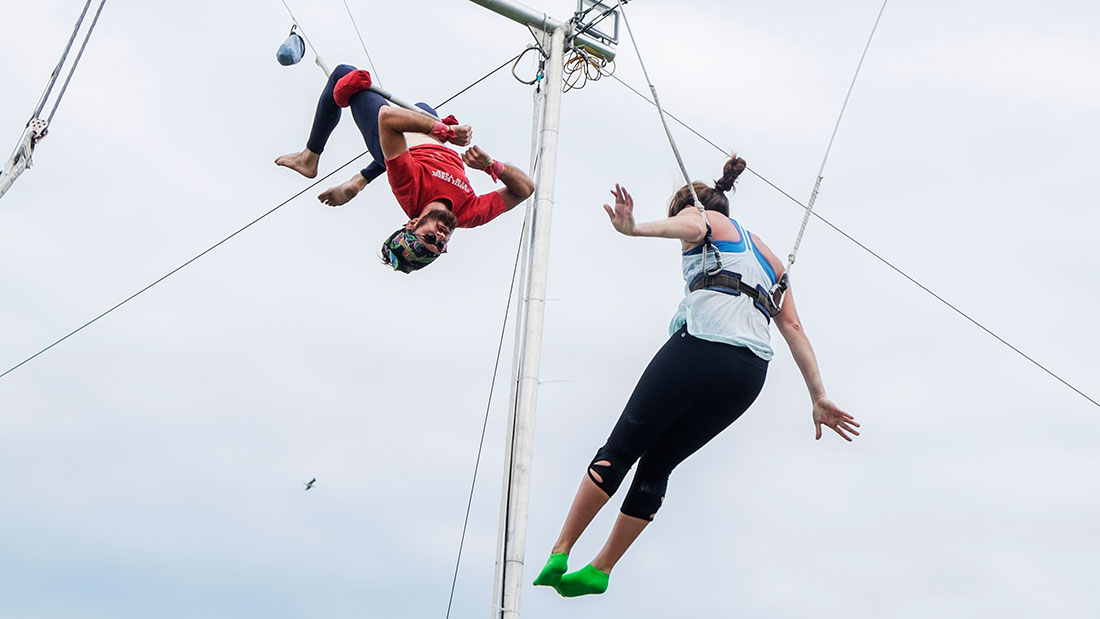By Pat Nabong
The circus once was associated with P.T. Barnum’s “freak show,” which for almost a century made a spectacle out of Siamese twins, the vertically challenged and people with deformities.
Things have changed. People have begun to see the circus as more than a form of entertainment. Now, in different cities in the U.S. and globally, the circus is considered as a sport, an art and even a form of therapy with many health benefits.
Circus arts
Whether it’s through clowning, acrobatics, balancing on a tightrope or flying on a trapeze, circus activities affect one’s physical and mental health.
“Abs are a big thing in the circus. You do a lot of ab work, a lot of pull up style work,” said Steve Hammes, a trainer who’s been working in the Trapeze School of New York in Chicago for over 11 years. “But I think the whole body gets a good workout.”
Because circus acts are usually done with a partner or in groups, social skills are developed as well. Research by occupational therapist Jill Maglio and Carol McKinstry, who has a master’s in health science, examined the Circus in Schools program in Australia and discovered that circus arts establishes a sense of community among its members.
Solidarity, cooperation instead of competition, trust and respect are also fostered through circus arts, according to a case study by Delphine Biquet about the impact of the Palestinian Circus School.
On the individual level, self-confidence and resilience are strengthened, according to Biquet. The circus also teaches risk management through assessing risky situations ‒ like jumping off the trapeze at the right time ‒ before doing it.
Beth Cooper trains at least once a week. “If I don’t train once a week, I’m not happy,” said Cooper.
After practicing circus arts for almost five years, Cooper thinks “it’s easier to face new challenges and any kind of obstacle. Once you’ve done that [trapeze], it’s easier to take on the next thing.”

(Pat Nabong / MEDILL)
Circus arts therapy
Circus arts may appear to be reserved for gymnasts and risk takers, but it is now being used as a form of therapy for children with ADHD, people with developmental delays and cancer survivors. The difference is that circus arts is more recreational while circus therapy is more therapeutic and designed for people who have special needs, said Carrie Heller, clinical social worker and founder of the Circus Arts Institute in Atlanta which combines play therapy with circus arts.
“Circus activities are delivered to increase functional motor patterns and cognitive processes related to executive functions,” said Maglio who is the founder of Holistic Circus Therapy in New York. “For example, impulse control, self-awareness, memory, following multiple-step directions, perseverance and problem solving are the focus points of bringing participants through a juggling activity.”
Because therapy in circus arts is innovative and relatively new, sessions and their durations vary depending on the organization. In Heller’s kind of circus therapy, which caters to children with ADHD and people with other behavioral, emotional and developmental challenges, the participants are taught to identify their emotions and read social cues while doing circus activities.
“Kids enjoy circus arts therapy as opposed to talk therapy,” said Heller. “A lot of kids on the autism spectrum and with delays often don’t want to exercise, so doing circus is a fun exercise. They’re motivated to do it and they get strong while they’re here.”
Circus for Survivors in Boston functions as a support group in which clients are taught to succeed in balancing, aerial and clowning activities. According to founder Suzanne Rappaport, who has a doctorate in occupational therapy, some survivors do not want to feel like sick patients in traditional support groups. Accomplishing circus tasks makes them feel more physically and mentally capable, strengthens cardio-muscular strength, mental and emotional endurance and increases survivors’ self-efficacy and self-confidence, said Rappaport.
“I feel like even in the moment, their affect is lifted through the group. They leave rejuvenated and happier than they came in,” said Rappaport.
Now that the circus has evolved to accommodate people of all ages with different capacities, the phrase “come one, come all” has never been truer.
the Trapeze School of New York at Belmont Harbor in Chicago. Sept. 23, 2016. (Pat Nabong/MEDILL)
Save


